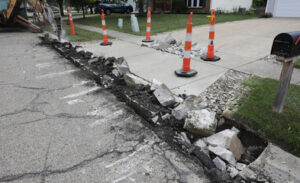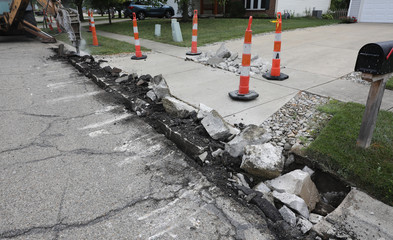There are many signs that homeowners need to pay attention to when deciding if it’s time for driveway replacement. Small cracks should be patched as soon as they appear to prevent them from becoming deeper and wider. To learn more, visit Driveway Replacement Colorado Springs.
 But sometimes large potholes and a sunken area suggest that it’s not worth repairing the damage. If so, replacement is the best option.
But sometimes large potholes and a sunken area suggest that it’s not worth repairing the damage. If so, replacement is the best option.
The type of material used to construct a driveway is one of the most important factors in its longevity. A durable, weather resistant material is essential, particularly if your area experiences frequent rain or flooding.
Asphalt and concrete are two of the most popular choices among homeowners. Both are cost effective and work well in most climates, but they require a bit more maintenance than other materials. Asphalt requires frequent resealing and has a shorter lifespan than other materials. Concrete can last up to four decades but is expensive. Its lifespan can also be extended with proper care, including resealing every three to five years and a protective coating.
Bricks and cobblestones are attractive options for those looking to add a decorative element to their driveway. They are more expensive than other materials but are extremely durable when properly maintained. Bricks and cobblestones can withstand heavy weight and are easy to repair, although they do require more regular maintenance and upkeep than other types of pavement.
Cracks are common in any driveway, but they can become worse if left unattended and allow water to seep into the ground and freeze. This erodes the soil around your home and allows cold temperatures to cause additional damage. Small cracks can be repaired with inexpensive crack filler bought at the local hardware store, but large cracks may require professional attention.
If your driveway has significant heaving or sinking, it’s likely time for a complete replacement. This is usually more costly than repairing a damaged area, but it will give you a new, stable surface that works well in your climate and meets your driveway goals.
If you’re environmentally conscious, consider a porous asphalt alternative that lets rainwater soak into the ground without running off. Standard asphalt has only about 3% void space for water runoff, while its porous counterpart offers up to 16%. It’s a great way to help the environment and save on your energy bill. If you live near the beach, crushed shell driveways are another ecofriendly option. Teams harvest the shells without damaging shorelines and then cement them into a hardy mixture for your driveway.
Design
When replacing a driveway, it is a great opportunity to improve its appearance and make it a focal point of the house. A new and well-designed driveway is sure to impress friends, family, neighbours and anyone who passes by.
Several factors can influence the design of a driveway, from drainage considerations to the type of material used. Gravel is the cheapest option but requires frequent maintenance to rake, clear weeds and top up levels. Concrete blocks or paving are more expensive but look great and are easy to replace if damaged. Resin bound surfacing is an attractive and cost-effective alternative, offering the flexibility of adding a colour or pattern to suit the style of your property.
Good drainage is crucial for the long life of any paved surface, including a driveway. The design of a driveway should incorporate a natural slope so that surface water will run off into the surrounding ground or, in sloping areas, to a drain. It is also advisable to install drains at the edge of a driveway where it meets the road to prevent flooding.
For asphalt pavements, an effective subgrade should be laid prior to construction of the final pavement layer. This may require the removal of excess soil to achieve a suitable grade, and then the subgrade should be thoroughly compacted with a mechanical roller. It is also a good idea to treat the subgrade with a soil sterilizing agent, to keep vegetation from growing through the pavement layers.
In most situations, a drainage problem can be solved by the use of site drains, which are generally installed in gullies or in the side of the driveway near a drain. In some cases, a trench drain can be placed under the driveway to collect water that may flow underneath the pavement. This water can then be piped to a drain or into the existing drainage system of the property.
Resurfacing a driveway is an excellent opportunity to correct areas of poor construction, oxidation or damage caused by automobile fuel and oil spillage. A properly constructed and maintained asphalt resurfacing will last for many years and improve the overall appearance of the driveway.
Installation
A new driveway will add value to your home and a fresh look that will boost curb appeal. However, it’s also a substantial investment that you should consider carefully before hiring a contractor. Choosing the right materials and getting professional installation are key to a long-lasting, durable driveway. It’s important to work with a reputable, licensed asphalt or concrete contractor who can show you photos of recent jobs and is willing to give references. Make sure they are bonded and insured for your protection.
General wear and tear, freezing temperatures and the weight of vehicles will eventually cause any surface to crack. Hairline cracks that are no more than 1/4 inch wide can be patched to extend the life of your driveway. Larger cracks allow water to seep in and freeze in cold temperatures, further eroding the driveway base. If the cracks are widespread, it’s time to talk to a paving pro.
During installation, the contractor will grade and prepare the soil with gravel for proper drainage and install a layer of asphalt or sand, depending on your chosen material. They’ll then cover that with a thick layer of your choice. Asphalt and sand typically last between 15 and 20 years, while concrete can last up to 40 or 50.
Some people prefer a more natural look, which can be achieved by using pavers instead of asphalt or concrete. However, they’re more costly than other types of material, and you’ll need to have them re-set or re-levelled regularly. Additionally, pavers can be damaged by frost and roots, so they’re not ideal for every climate.
If your existing driveway has serious damage, it may be necessary to replace it altogether. Major damage can indicate that the concrete wasn’t poured properly, or that there are drainage problems. Often, these issues are a result of poor soil preparation. It’s always wise to choose a professional who can show you photos of driveways they’ve completed in the past four or five years. You should also be able to inspect the work yourself before signing any contracts.
Maintenance
If your driveway has significant damage or is approaching the end of its useful life, it may be time to consider repair or replacement. A well-maintained driveway increases the value of your home, adds safety and function to your yard, and makes a nice first impression when guests arrive at your door. But it’s important to know when repairs are necessary, what options are available for your situation, and how much a repair or replacement project will cost.
Driveway repair can be relatively inexpensive if the cracks and holes are limited in size. Surface cracks and potholes are common as aging and wear-and-tear take their toll on any material, but if they’re allowed to continue to grow, they can allow water into the structure of your driveway and lead to deterioration or even failure. Filling or patching these cracks can keep them from becoming worse, as they’ll prevent the trapped water from freezing and expanding, which will cause further damage.
Larger cracks in a driveway can be repaired with asphalt, cold-patch concrete or other specialty materials. However, these repairs should be followed by a coat of sealer to ensure the longevity of the repair and to protect against further damage from weather or debris. It’s also worth investigating the possibility of resurfacing or replacing the entire driveway if its damage is extensive, as these solutions are generally more cost-effective in the long run.
In addition to reducing curb appeal, a cracked or damaged driveway creates a tripping hazard for pedestrians and is difficult to navigate for vehicles. It can also erode the soil underneath and if the damage extends to your foundation, can cause basement leaks.
If your driveway is not draining properly, you may need to replace it. If the damage extends to the point that it’s causing erosion of soil or washing out of gravel and sand, this is usually a sign that your driveway has a serious drainage design problem, which will likely require substantial digging and excavation. It’s also a good idea to compare the costs of resurfacing or replacing your driveway with the cost of installing a new drainage system.
